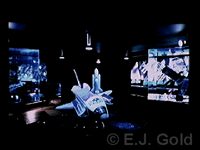 An arm in space, a remote manipulator system, a beam builder, a manned maneuvering unit, a cherry picker. It sounded like fiction, but it was all factóthere to see.
An arm in space, a remote manipulator system, a beam builder, a manned maneuvering unit, a cherry picker. It sounded like fiction, but it was all factóthere to see.
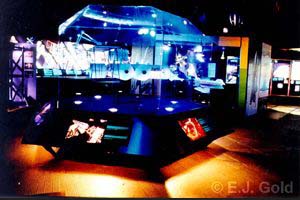 After the speed of light grand tour of the Universe, visitors could catch a glimpse of the new era in space we were about to embark upon, the Space Shuttle era, the MADE IN SPACE era. They would learn about new hopes for mankind: space labs, factories, depots, orbital stations, solar power satellites, and even space colonies. The scenario for the future was drawn out in detail.
After the speed of light grand tour of the Universe, visitors could catch a glimpse of the new era in space we were about to embark upon, the Space Shuttle era, the MADE IN SPACE era. They would learn about new hopes for mankind: space labs, factories, depots, orbital stations, solar power satellites, and even space colonies. The scenario for the future was drawn out in detail.
 An arm in space, a remote manipulator system, a beam builder, a manned maneuvering unit, a cherry picker. It sounded like fiction, but it was all factóthere to see.
An arm in space, a remote manipulator system, a beam builder, a manned maneuvering unit, a cherry picker. It sounded like fiction, but it was all factóthere to see.
Models nearly 10 feet in size included the Shuttle Orbiter with open cargo bay and remote manipulator system, the Glaser solar power satellite which was displayed in a beautiful case mimicking the shape of a flying saucer, a model of an orbiting station produced by our in-house model-maker par excellence, Claude Bernier, a boat builder and homme-ŗ-tout-faire, and a seven-foot replica of the Ames research Center model of the Bernal Space colony. Smaller models included a Space Telescope from Marshall Space Flight Center, Grummanís Beam Builder and samples of featherweight aluminum beams, connectors and special alloys for building in space from Langley Research Center; a completely articulated eight-foot Shuttle model from Rockwell International, solar collectors from Lockheed, and real samples of space food.
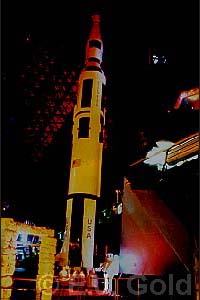 Wax reproduction of an original sculpture by L. Corriveau displayed in Strange, Strange World, 1978-1981
Wax reproduction of an original sculpture by L. Corriveau displayed in Strange, Strange World, 1978-1981
|
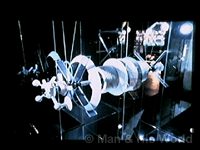 All in all what I managed to do was a great PR job for the American government and its space program. I was promoting the idea of space exploration in a very professional way and I made them look good. That was not my intention, but nor was I adverse to it. The US government was doing a good job and that to me was important to recognize. I believe they were very satisfied with my efforts.
All in all what I managed to do was a great PR job for the American government and its space program. I was promoting the idea of space exploration in a very professional way and I made them look good. That was not my intention, but nor was I adverse to it. The US government was doing a good job and that to me was important to recognize. I believe they were very satisfied with my efforts.
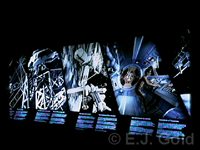 I kept in touch with, or rather they kept in touch with me and even offered me some translation work at a later date. But most importantly, they invited me to attend a dinner at the home of the American Consul in Montreal which would be attended by just a small handful of local individuals of importance and the very first two astronauts to use the Space Shuttle Dr. Richard H. Truly and Joe H. Engle. Truly later went on to become the head of NASA for several years until he was hacked down like everyone before him. It was a memorable dinner for me where I felt slightly intimidated. It was very impressive meeting these heroes of the day. I remember vividly being struck by the fact that the astronauts seemed exhausted and under a lot of pressure. They looked like they could use a break. But it didnít seem forthcoming.
I kept in touch with, or rather they kept in touch with me and even offered me some translation work at a later date. But most importantly, they invited me to attend a dinner at the home of the American Consul in Montreal which would be attended by just a small handful of local individuals of importance and the very first two astronauts to use the Space Shuttle Dr. Richard H. Truly and Joe H. Engle. Truly later went on to become the head of NASA for several years until he was hacked down like everyone before him. It was a memorable dinner for me where I felt slightly intimidated. It was very impressive meeting these heroes of the day. I remember vividly being struck by the fact that the astronauts seemed exhausted and under a lot of pressure. They looked like they could use a break. But it didnít seem forthcoming.
| -- Linda Corriveau |
 Click on this banner to visit the T.O.C.
Click on this banner to visit the T.O.C. |